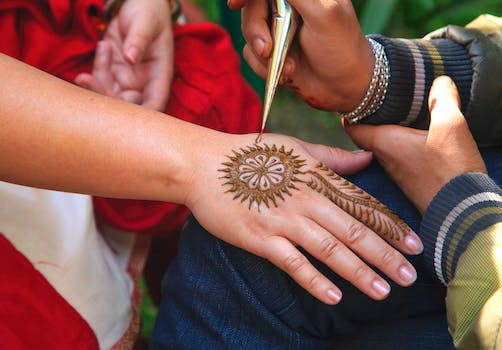-
Table of Contents
- The Art of Mehndi Design
- The History of Mehndi
- Origins of Mehndi
- Cultural Significance
- Styles and Techniques
- Application Techniques
- Conclusion
- Q&A
- Q: How long does a mehndi design last?
- Q: Are there any cultural taboos associated with mehndi design?
- Q: Can anyone learn to create mehndi designs?
- Q: What are some tips for caring for a mehndi design?
- Q: Are there any health risks associated with mehndi design?

Mehndi, also known as henna, is a form of body art that has been practiced for centuries in various cultures around the world. The intricate designs created using henna paste have become a popular form of temporary body decoration, especially during special occasions such as weddings, festivals, and religious celebrations. In this article, we will explore the history of mehndi design, its cultural significance, and the different styles and techniques used to create stunning henna patterns.
The History of Mehndi
The art of mehndi dates back to ancient times, with evidence of its use found in various cultures including Indian, Pakistani, Middle Eastern, and North African societies. The practice of applying henna paste to the skin for decorative purposes has been a tradition passed down through generations, with each culture adding its own unique twist to the art form.
Origins of Mehndi
The exact origins of mehndi are unclear, but it is believed to have originated in ancient Egypt and spread to India and other parts of the world through trade routes. In India, mehndi is an integral part of weddings and other celebrations, with intricate designs applied to the hands and feet of the bride and other female family members as a symbol of good luck and prosperity.
Cultural Significance
In many cultures, mehndi is considered a form of self-expression and creativity, with each design telling a unique story or representing a specific meaning. For example, in Indian culture, certain motifs such as peacocks, lotus flowers, and paisley patterns are commonly used in mehndi designs to symbolize love, beauty, and fertility.
Styles and Techniques
There are various styles and techniques used to create mehndi designs, each with its own unique characteristics and cultural significance. Some of the most popular styles of mehndi include:
- Indian Mehndi: Known for its intricate patterns and fine details, Indian mehndi designs often feature floral motifs, paisley patterns, and geometric shapes.
- Arabic Mehndi: Characterized by its bold and flowing designs, Arabic mehndi often includes large floral patterns, vine motifs, and intricate lace-like patterns.
- Pakistani Mehndi: Combining elements of Indian and Arabic styles, Pakistani mehndi designs are known for their elaborate patterns and use of shading and filling techniques.
Application Techniques
The art of applying mehndi involves using a cone or syringe-like tool to create intricate designs on the skin. The henna paste is left to dry for several hours, after which it is scraped off to reveal a reddish-brown stain that can last for up to two weeks. Some artists also use glitter, gems, and other embellishments to enhance the beauty of the design.
Conclusion
Overall, mehndi design is a beautiful and intricate art form that has stood the test of time and continues to be a popular form of body decoration in many cultures around the world. Whether you are looking to adorn your hands and feet for a special occasion or simply appreciate the beauty of henna art, mehndi design offers a unique and creative way to express yourself.
Q&A
Q: How long does a mehndi design last?
A: A mehndi design can last anywhere from one to two weeks, depending on factors such as the quality of the henna paste and how well it is cared for.
Q: Are there any cultural taboos associated with mehndi design?
A: In some cultures, it is considered inappropriate to apply mehndi designs to certain body parts, such as the feet or lower back, as they are considered sacred or impure.
Q: Can anyone learn to create mehndi designs?
A: Yes, with practice and patience, anyone can learn to create mehndi designs. There are many online tutorials and workshops available for those interested in learning the art of mehndi.
Q: What are some tips for caring for a mehndi design?
A: To prolong the life of your mehndi design, avoid washing the area with water for the first 24 hours, apply a mixture of lemon juice and sugar to the design to enhance the color, and avoid using harsh chemicals or lotions on the area.
Q: Are there any health risks associated with mehndi design?
A: While natural henna paste is generally safe to use, some people may experience allergic reactions to certain ingredients in the paste. It is important to do a patch test before applying henna to a larger area of skin.






